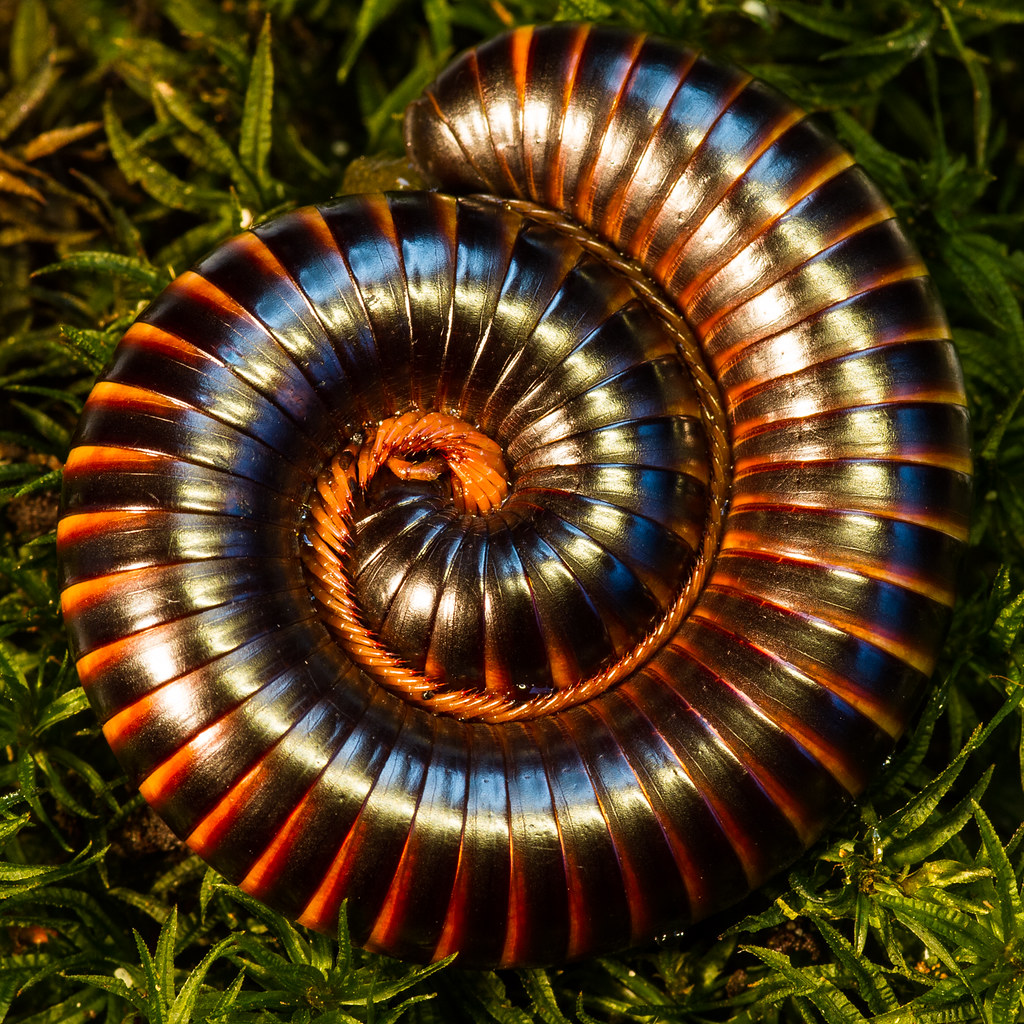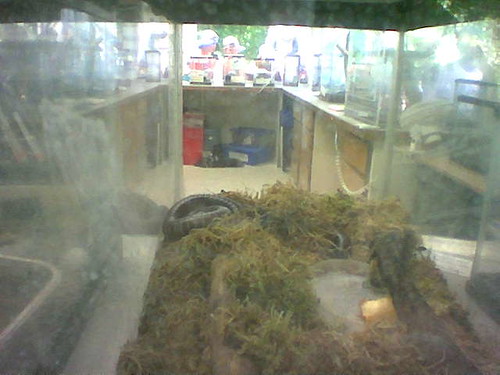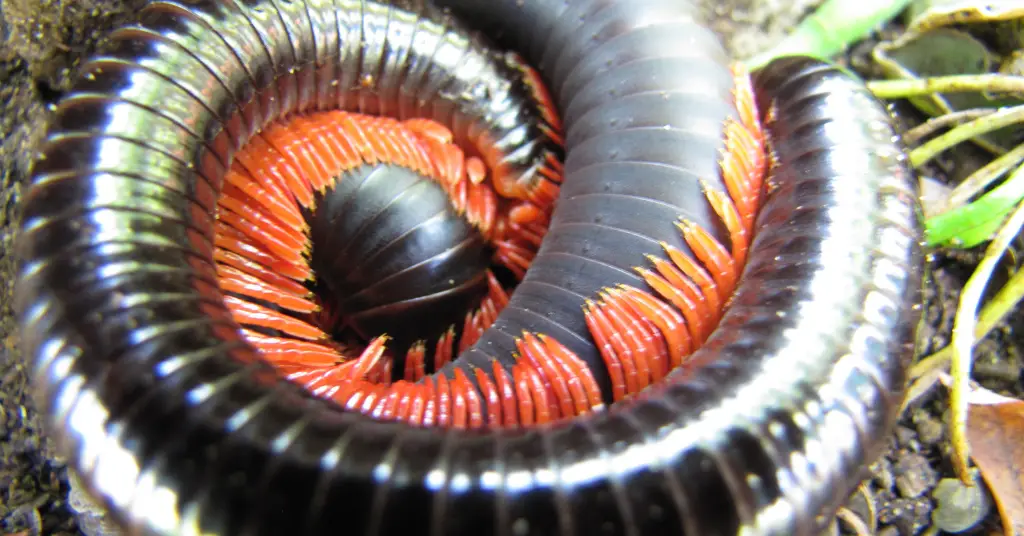
Jeffery Jago is a expert in horticulture and worm breeding. With a background in plant cultivation
Last Updated on June 5, 2022 by Jeffery Jago
Millipedes are interesting creatures that can make great pets for the right person. They’re easy to care for and don’t require a lot of maintenance, but there are a few things you should know before bringing one home.
In this article, we’ll provide you with all the information you need to get started, including a care sheet, pictures, and advice.
(Note: This article references the most popular of the pet millipedes, the giant African millipede. For further reading on other species, check here).

Table of Contents
- Giant African Millipede Care Sheet
- Millipedes Overview
- Appearance and variants
- Price Range
- Behavior and Temperament
- Caring for a Giant African Millipede
- Fun Facts about the Giant African Millipede
- Final words:
Giant African Millipede Care Sheet
| Name of species | Archispirostreptus gigas |
| Family | Spirostreptidae |
| Common name | giant African millipede or shongololo |
| Category | Kingdom: Animalia Phylum: Arthropoda Subphylum: Myriapoda Class: Diplopoda Order: Spirostreptida Genus: Archispirostreptus |
| Native location | East Africa, Mozambique to Kenya |
| Size | 33.5 centimeters (13.2 in) in length, 67 millimeters (2.6 in) in circumference |
| Diet | Herbivore |
| Temperament | Docile, Peaceful |
| Tank Column | Varies from the bottom substrate to crawling up branches, Digs |
| Water Params | 72-75°F (22-24°C) 75 to 80% Humidity |
| Lifespan | 7-10 years |
| Experience level | Intermediate |

Millipedes Overview

Synonyms
Spirostreptus gigas
Aethiopistreptus attemsi
Spirostreptus plumaceus
Spirostreptus semicylindricus
Spirostreptus opistheurys
Spirostreptus msalaensis
The giant African millipede is a large, brown, and black millipede that can grow up to 13 inches long.
The giant African millipede is the most popular millipede pet in the united states due to its large size and docile nature.
Due to a certain type of mites that wild millipedes carry, importation into the country is illegal. However, Breeding within the country is legal and is most likely where your pet millipede will come from.
These pets require very little in the way of setup to be happy and flourish and can be picked up and handled (with care). They do not bite and tend to be very docile and friendly.
These millipedes can share enclosures with several other species of animals without any issues, which makes them a great addition to various types of terrariums and vivariums, such as keeping millipedes with dart frogs.

Appearance and variants
Giant African millipedes mostly only come in black to slightly reddish-brown. They have 256 yellow to red legs, two antennules, and two pairs of antennae. Their bodies are long and cylindrical with small plates running down their backs.
Males have smaller plates on the underside of their tails while females have larger ones. There is also a noticeable difference in head shape between the sexes but it can be difficult to tell them apart if you are not experienced.
There is not much variety in this species, however, there are several other species of giant millipede that can vary in color all the way to the pink dragon.
Price Range
The average pricing per giant African millipede is $10 USD to $20 USD. Some may go for higher if they have more rare desired traits.
Behavior and Temperament

Giant African millipedes are nocturnal animals that spend the majority of their time burrowing or hiding in dark, humid places during the day. At night they will come out to forage for food. They are not very active creatures and do not move around a lot.
They are docile animals that do not bite, but you may feel a nibble on your skin which is harmless.
If they feel threatened they will curl up into a tight ball as a form of defense. If handled too much they can secrete a fluid from their bodies that can cause irritation to humans so it is best to avoid handling them too much, but handling with care is fine.
They are social creatures and do well in groups but can also be kept as solitary pets. If you do keep them in a group, it is best to have one male per two to three females.
They have a lifespan of anywhere from 5-10 years but some have been known to live up to 20 years in captivity.
They will attempt to climb hardscape and plants in their enclosure so it is best to provide them with something to climb on like a piece of driftwood or rocks.
That also means any plants you have should be able to bear the weight without falling or breaking.
Real plants are preferable, but keep in mind they will nibble on leaves and bark and wood hardscape.

Caring for a Giant African Millipede
Caring for a giant African millipede is pretty straightforward. They are not demanding pets and as long as you provide them with the basic needs, they will do just fine.
Temperature and Humidity
Millipedes don’t require much in the way of temperature and humidity. They do best in a temperature range of 72-75°F (22-24°C) with a humidity level of 75 to 80%.
They can tolerate a wider range of temperatures and humidity levels but this is the optimal range for them. If the temperature gets too hot or too cold it can stress them out and make them more susceptible to disease.
The humidity level is important because millipedes need to keep their bodies moist or they will start to dry out and die. If the humidity is too low you can mist their enclosure with a water bottle a few times a week or use a humidifier.
If the humidity is too high it can lead to mold and mildew growth in their enclosure which can make them sick.
Enclosure Size
When it comes to enclosures, bigger is always better. They are not very active creatures so they don’t need a lot of space to move around. A 10-gallon (38 L) tank is the minimum size you should get but a 20-gallon (76 L) tank is even better.
If you are keeping more than one millipede together, you will need to increase the size of the enclosure accordingly.
Whatever enclosure you buy, You will need a tight-fitting cover to go along with it. Millipedes are very good escape artists and will find any small opening to squeeze through. A screen top is not enough because they can climb up the sides of the tank and escape that way.
Substrate
The substrate is the material you use to line the bottom of the enclosure. For millipedes, the substrate should be at least 4 inches (10 cm) deep.
A deeper substrate is even better because it will allow them to bury themselves if they want to.
A good substrate for millipedes is a mix of coco coir and topsoil. You can also use peat moss or vermiculite.
The ideal mix is:
- Approximately 25% high-quality compost, 25% coco fiber, and 50% crushed leaf litter. Top with a 2-inch layer of crushed leaf litter.
Avoid decaying wood, pine needles, and any potentially poisonous plants.
The substrate should be damp but not wet. If it is too dry the millipede will start to dry out and die. If it is too wet the substrate can mold which can make the millipede sick.
You can mist the substrate with a water bottle a few times a week or use a humidifier to keep the humidity level up.
Adding isopods and springtails is a great idea. These will act as a janitorial crew as well as bring extra life to an otherwise sterile environment.
Tank Setup

Millipedes like a lot of darkness so providing many hiding spots is a good idea.
You can use rocks, driftwood, or anything else that will provide them with a place to hide.
Just make sure whatever you use is safe for them to climb on and won’t fall and crush them.
Plants are also a great addition to their enclosure. They will help with humidity levels and give the millipede somewhere to hide.
Any plants you have should be able to bear the weight without falling or breaking.
Keep plants short enough not to bust threw the lid as the millipedes can use those as a way of escape.
Real plants are always better, But fake plants can be used as well.
Diet & Feeding
When it comes to diet, giant African millipedes are opportunistic feeders and will eat just about anything.
Their primary diet will consist of leaf litter and wood.
In addition to leaf litter and wood, You should offer various fruits and vegetables such as carrots, kale, apples, cucumber, banana, etc.
Zoos will also often supplement their diet with tortoise food as it’s packed with proteins and other nutrients they need.
A good rule of thumb is to offer them food that is no bigger than their body.
Millipedes don’t necessarily need a water bowl if their cage humidity is high enough. They get most of their water from food and humidity levels.
That doesn’t mean you shouldn’t add a shallow dish of standing water for them to sip out of, Just be sure it’s not deep enough for them to drown in.
Cleaning & Maintenance
Cleaning and maintaining a millipede enclosure is pretty easy.
The substrate will need to be replaced every 6 to 12 months.
Every few months you can also do a deep clean where you completely empty out the enclosure and start from scratch.
If you’ve added a cleanup crew, this can extend the time you need to clean the cage quite a bit.

Fun Facts about the Giant African Millipede
Male Millipedes Court Females With Songs and Back Rubs.
The eggs of millipedes are laid in nests.
Millipedes were possibly the first animals to live on land.
Final words:
The giant African millipede is a popular pet for people who are looking for something a little different. They are easy to care for and don’t require a lot of attention. Despite their name, they are actually relatively docile creatures that make great pets. If you’re thinking about getting a millipede, be sure to do your research so you can provide them with the best possible care.

